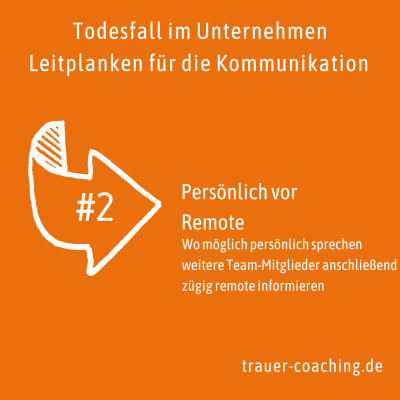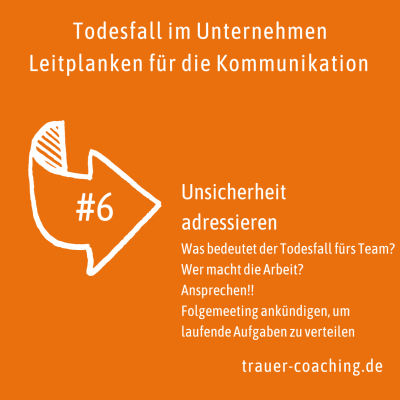
When a Team Member Dies — Guidelines for Communication
When a team member dies, this is also a job for internal communication.
- To have the colleague's interests at heart,
- while not violating the deceased person's privacy,
- and respecting the bereaved family's wishes.
In the event of a death within the company, a team lead's or HR expert's reaction directly influences employee experience. As in every crisis, communication is key, and handling the communication part of a crisis like the death of an employee directly reflects the corporate culture.
The most important rule is: The person taking to team members and relatives should feel comfortable doing so, that is without appearing insecure, too smooth or even lacking empathy. A fast response is of advantage only if the response is genuine, well-thought-out, and appropriate to the situation. This blog article provides tips and guidelines for communication in the rare event of a “death in the company”. Please also consult this article with a checklist for HR experts.
Be prepared and prep your organization for cases of bereavement and personal crisis:
♦ Workshop on Grief-Management ♦
Ideally, you can distribute different communication tasks among several people: one or two managers are responsible for communication within the company; one person is responsible for contacting the bereaved (or grieving employees). A third person informs customers or partners if necessary. You may already be familiar with this type of division from a crisis communication plan.
This automatically establishes an internal comms group that trumps having to act alone::
- Information can be shared here, which is helpful to unburden oneself without breaking confidentiality.
- Ideas can be discussed in a small peer group with a chance for feedback
- Storyline and tone of voice can be established collaboratively , respecting several stakeholder's concerns
- There is a support network for preparing and debriefing delicate steps (similar to supervision as a standard quality stepin the social and charitable sector).
It is a great relief for many bereaved people if a dedicated company rep maintains contact with the bereaved family , at least in the first few days after the death of a loved one. This eases the mental load as the bereaved do not need to find out who they need to talk to, and they do not have to explain the situation or answer questions multiple times. This helps safe energy that is most likely not avaibable.
The right person for this can be the manager or team lead alternatively someone from HR. There are cases when a colleaguewho knows the deceased colleague or the family well can be a good choice to sty in contact with the deceased's family.
Depending on a company's size, company culture, and the deceased employee's role, someone form the managing team can initiate contact with the family, to offer condolences, thus showing respect and appreciation (also seen by other employees).
Later, there can be more than one person of contact.Here it makes sense to divide between topics. A widow might like talk about financial details with someone from the HR department, not a manager. If it is possible for an HR employee to be approachable for all HR matters or to act as a guide, this can also be helpful after the first few weeks.
Guidelines for Internal Communication
Build Trust through Communication (or Loose It)
In the event of a death of an employee, information and communication should be in the hands of a manager .
It does not have to be a managing director; every manager can inform their teams.
No matter what task you take on in the event of a death of an employee: Think of communication as a team sport. communication as a team sport, bei dem Sie sich miteinander vorbereiten.
Also: Prepare! Don't be afraid to rehearse what you want to say at the all-hands meeting on the death of the team member. Write the text for the announcement in collaboration with your communication experts. And coordinate important messages with other managers in advance.
On a sad occasion such as an employee's death, every comment needs to be the right one. After all, it is all too easy to lose the trust of your employees with an unfortunate choice of words.
The following guidelines can help prepare for grieving employees in your organization. Adapt these to your specific situation in a Workshop on Grief Management.
Onion Structure
Think of communication as an onion: The manager or team lead should learn about a loss first, then the direct colleagues or the team. If the deceased was a manager themselves, the “orphaned team” should be the first to hear the news of the death. Also think of colleagues who are friends with the deceased / the bereaved and consider who will break the news to them. Maybe they already know about the loss through private channels — in that case you might want to suggest confidentiality.
Next in the informational onion are the members in larger teams or business units, at sites, then the entire company. If it is a small company where everyone knows each other, the team can be informed as a whole. Only then are business partners and other externals.
In Person whenever Possible
If you see a chance to inform colleagues in person, do so! Also ask team members to give you a chance to talk to team members who are not on ite and who are also closely involved in the team.
Plan time for questions and emotional reactions for every conversation; make and take time between conversations to prepare yourself for the new group and also see how you are doing yourself.
Prep Answers and Offers
There is no one day to break the news of a loss. It depends on the people, their relations, the culture...
- Imagine scenarios of how people might react to the news of this death/loss.
- Are there supporting services for employees you can prep? Who can employees talk to - if necessary or if they are severely affected - think of talks with coaches, internal "Vertrauenspersonen", you yourself? And maybe prep the internal or external partners.
- Practice what you want to say, for example when talking about the cause of death. This way you are sure to maintain confidentiality and respect towards the deceased or the bereaved .
- The questions that first sprang into your mind might also be on the minds of your employees. What are the answers?
- Phrase answers in advance, esp. for questions you cannot answer. E.g.: I understand that this is on your mind. I hope you understand that I am not allowed to say anything about this now, as this is confidential / as we do not now yet / as we want to talk to X first."
Reduce Uncertainty AND be Prepared to Endure Emotion
You will probably see very different reactions: Some individuals may be shocked and find themselves speechless. Some may spontaneously start to cry or leave the room. This is not a bad thing, as long as it does not unsettle you.
Someone might ask what will this means for the team. This is natural: when a colleague dies, this impacts on the workload of the other employees. It is a legitimate concern of employees to learn what will happen next or when a distribution of tasks will be discussed.
Address the Distribution of Work and Workload
Announce when you will discuss work distribution, upcoming projects, etc. as soon as possible. Combine this with a request that your colleagues think about upcoming projects - this way you will find out about tasks that you may not have thought of.
Depending on the mood in the room, it helps if you address the additional workload directly. This signals: "I have this on my radar." And you make it easier for employees to address an overload if it is bothering them.
Reduce the Pressure where Possible
Individual employees may react strongly to the news of a death. In addition to a close bond with the deceased, their fears may dictate a strong emotion response, or painful experiences may suddenly come to light (which many people might find inappropriately in work context).
Das können Sie als Führungskraft nicht vermeiden, und in vielen Fällen reicht es als Reaktion eventuell schon, wenn Sie Druck aus dem aktuellen Arbeitstag rausnehmen.
This is especially true if the team is currently in a critical project phase or is otherwise under pressure. Make this a topic of discussion. Phrases such as “Think about what you need today” or “With all the pressure we're under right now because of project X...: A colleague has died. That can shake us up” can have a relieving effect and open up a conversation about what needs to be seen to today and what can wait until tomorrow.
Suggest a Joint Response
After you have provided information, there may need to be room for questions and, above all, reactions. Then make a suggestion as to what the team could do together: Prepare a joint condolence card or consider sending flowers to the bereaved. In some companies, a memorial is appropriate, or a farewell book that the bereaved receive later. The important thing is that it fits in with the team.
Respect a Colleague's Right to Privacy
If, in the event of a death of an employee, there are colleagues with friendly ties to the deceased, they may know more details than you do and be willing to talk about it among colleagues. It is advisable to talk about the privacy of the deceased and their relatives.
This respects the bereaved right to privacy, and the deceased's ongoing claim to respect. This means that the deceased's family can decide what information about the death of their loved one can be public knowledge within the company.
Honouring the Right Not To Know
Not every employee wants to be confronted with details when a colleague dies. Regardless of the reasons, they have a right not to be told more than is important for their job. Respect this attitude publicly so that it does not lead to irritation in the team. Work with the people in your team to find a way in which other colleagues can still show sympathy.
Handling an employee's demise?
Contact me at +49 179 2601797
Special Case: a Former Colleague Dies
These guidelines are based on the death of an active colleague. If a former employee dies, the death may only affect part of the workforce. You may need to take this into account when communicating with the team by organizing the discussion groups differently.
Give new colleagues the opportunity to learn about the person's heritage within the company: Back then, she introduced the CRM that we work with. He introduced this process and continued to improve it. She was the one who remembered every birthday. Taking good care of us as trainees was particularly important to him.
Special Case: Suicide
With a death by suicide, the need for confidentiality is even more important. It is advisable to show particular respect for the deceased, combined with communication that explicitly emphasizes the rights of the bereaved to privacy.
- "Even if X has died, I, as his_her manager, am committed to the relationship of trust/confidentiality. I hope you understand that I am not allowed to say anything about this."
- Make an explicit appeal to respect for the deceased: “Out of respect for (name of the deceased) and the bereaved, I would like to ask of you not to speculate about this.”
If it is a case of suicide in a professional environment, you will find a lot of valuable information in the publication or conseling services of self-help groups etc ..
Special Case: Occupational Accident
With the death in the workplace itself, some colleagues might feel insecure. It can be advisable to address this and apologize to both the bereaved and your colleagues.
A lawyer specializing in employment law will probably advise against this, as an apology can be construed as an admission of guilt. As a counter-position: clear communication counteracts the impression that things are being dragged out or covered up. This will prevent damage to employee loyalty.
Here too, keep in mind the need to balance between confidentiality and the need for information.
This is the second part of a series of blog articles.
- Part 1 links to and collects tasks for HR and managers when an employee dies.
- This article (part 2) adds guidelines for communication.
- Part 3 offers suggestions for employees after a colleague dies,
- Part 4 deals with the case when a colleague is grieving.
- Prepare your organization for an emergency through an individual Workshop in Grief Management: You individualize the communication guardrails, develop options for action and gather resources for managers.
Click here to see more










